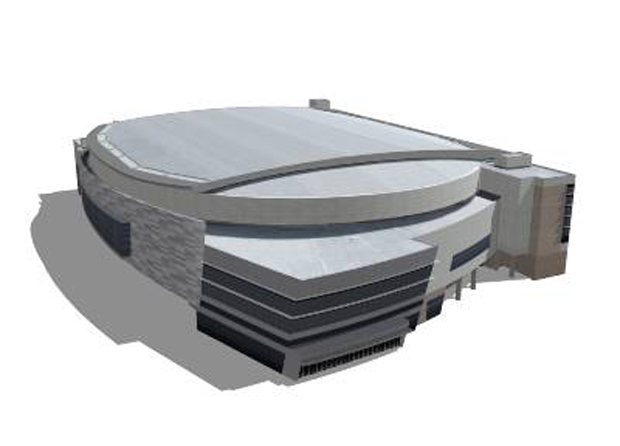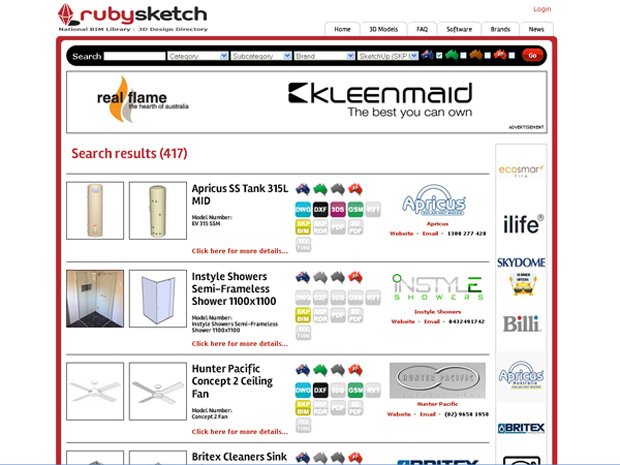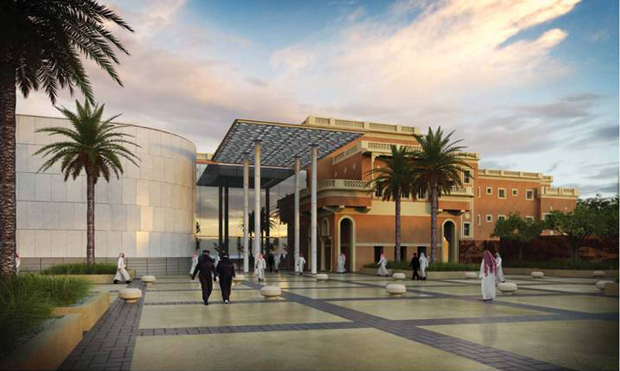Author : Geraldine Chua
The benefits of SketchUp and 3D models - software for specifiers
Have a quick browse through the computers at any architecture practice today (without getting thrown out) and you’ll surely come across the programs Autodesk Revit, AutoCAD or ArchiCAD.

Synonymous with computer-aided design (CAD) and Building Information Modelling (BIM), which is the digital representation of the physical and functional characteristics of a project, these systems are the virtual cornerstone of buildings; a shared knowledge resource for information about a facility.
So where does SketchUp, a 3D modelling software that claims to be the “antidote to complicated, expensive CAD software”, fit in?
SketchUp was originally developed by startup company @Last Software in 1999 as a general-purpose 3D content creation tool, envisioned as a program that would allow design professionals to emulate the feel and freedom of working with pen and paper.
The idea was that if architects, designers, builders, makers and engineers were not unnecessarily bogged down by figuring out how to work the interface, they could focus on what they could create with it.
Attracted to its Google Maps plugin, Google bought the program in 2006. Under the hands of the internet search giant, SketchUp grew in size and scope, so that by 2012 – the time of its acquisition by surveying and navigation equipment company Trimble – it had approximately two million active users every week.
Today the latest version of the 3D modelling platform, SketchUp 2013, features various capabilities and tools that allow users to explore, modify and share design ideas in 3D, import CAD plans and photos, and even develop communication and planning deliverables.
But, despite the improvements and changes, the core of the program is unchanged: simplicity and accessibility remain the elements that set SketchUp apart from other BIM software.
“The beauty is how quick and easy it is to use,” notes Tasman Storey, design principal at Sydney-based Tropman & Tropman Architects, who says the platform is a great initial design tool that can generate a whole series of interiors and exteriors, elevations and fly-throughs.
“You have some ideas and you can put them down on SketchUp in conjunction with some AutoCAD drawings. You can add to it quite quickly, and if you’ve got the skill to apply a render, within hours you can have the design solve.
“It’s one of those programs that you can start off and add to your knowledge as you work on it quite easily. People who can’t draw quite well, or are unsure of what their building is going to look like, can also fall back on something like SketchUp.”

Al Hamra Palace, or the Red Palace by Tropman & Tropman Architects. The design was created with SketchUp Pro.
Intuitive and easy to use, SketchUp does not require the skills and learning time needed of most other programs.
CLICK, SAVE, SPECIFY: BENEFITS OF 3D MODEL LIBRARIES
Balancing SketchUp’s design tool is the Trimble SketchUp 3D warehouse, an online repository where users can create, find and share collections of 3D models.
Promoting collaboration between users, the website is currently operated by Google and not only includes 3D trees and cars, 3D buildings that are geo-located, and 3D people to inhabit these buildings, but also encompasses collections of ‘real’ products – from Fisher & Paykel fridges to Alucobond wall panel systems.

Ford Center is a multi-purpose arena in downtown Evansville, Indiana. The model is available on the Trimble 3D Warehouse, and has received 5362 downloads.
However, the SketchUp 3D warehouse is not the only online library available, particularly when it comes to building products.
Probably the biggest multi-format BIM ‘supermarket’ in Australia is RubySketch, which does not host generic representations, but works directly with Australian product manufacturers to draw and add products to www.rubysketch.com.
“We will do research on a company and make an informed decision on how the product is related to the architect, in what context the model will be used, and how it will be searched,” says Andrew Dwight, CEO of RubySketch and AAD Build.
“We then collaborate with the product manufacturer to find out definable characteristics of the product, for instance, sustainability, visual properties, costs and weight of the product and other pieces of crucial information.”
Each downloadable model on the website contains specific information about the product.
Currently, architectural firms ranging from small 2-3 team operations to larger practices such as Suters and Cottee Parker utilise RubySketch. According to Dwight, the larger companies tend to distribute the downloaded models via their BIM managers and through to their staff. This means that in many cases, one model download from RubySketch can lead to over 150 architects specifying that product when on multiple jobs.

The main benefit that RubySketch offers is therefore similar to the advantages of SketchUp’s 3D library or a real-life centralised warehouse: easy access to a whole host of products.
With RubySketch, there is no need to scan the web for 3D content as it is all in one spot. All specifiers need to do is go to the website, search through the models by typing the name of the product or item code, choose a preferred model and download that model in their favourite software format.
Full rooms complete with tiles, floors, PC items and fixtures can also be downloaded.
“Having this type of information freely available to the design and construction community in one location, with all products having built in contact information, basically saves the architect time researching, the builder time sourcing, the estimator time quantifying, and the client trying to figure out what it is they are getting into before they actually on to construction phase, where cost comes into play,” explains Dwight.
Within the design process, this translates to having 3D models of potential products that could be used. When inserted on to SketchUp, architects and builders will be able to quickly visualise how a product will look like.
This ability to preview how a product will fit and perform in the context of a project can minimise potential design re-work. It also helps the project team gain a deeper understanding of how the products and design will work together.
3D libraries like RubySketch are therefore essential in bridging the gap between architects and manufacturers during the design phase.
“From our point of view as a manufacturer, we realise that the architecture industry is using these tools, and we want to make sure we have the resources available for them,” says Richard Michael of Steel Select, which has now been integrated into Bluescope Steel’s new website, steel.com.au.
“We make components and we make products for a range of software, but we leave the choice up to the architect and designer on how they want to create their models and building designs.”

Al Hamra Palace, or the Red Palace by Tropman & Tropman Architects. The design was created with SketchUp Pro. Image: Tropman Architects.
Bluescope is one manufacturer that jumped on the SketchUp 3D products bandwagon early on, providing free downloads of its roofing products on its website, including both renders (flat colour swatches) and textures (roofing and walling profiles).
However, while these online libraries allow architects and designers to ‘test’ and compare their design ideas before moving on to construction, the burning question of whether these products actually get specified in real life remains.
- Cover Story
-
 SketchUp Can Help You Win Interior..
SketchUp Can Help You Win Interior.. -
 Best Laptops for SketchUp
Best Laptops for SketchUp -
 How to Resize Textures and Materials..
How to Resize Textures and Materials.. -
 Discovering SketchUp 2020
Discovering SketchUp 2020 -
 Line Rendering with SketchUp and VRay
Line Rendering with SketchUp and VRay -
 Pushing The Boundary with architectural
Pushing The Boundary with architectural -
 Trimble Visiting Professionals Program
Trimble Visiting Professionals Program -
 Diagonal Tile Planning in SketchUp
Diagonal Tile Planning in SketchUp -
 Highlights of some amazing 3D Printed
Highlights of some amazing 3D Printed -
 Review of a new SketchUp Guide
Review of a new SketchUp Guide
- Sketchup Resources
-
 SKP for iphone/ipad
SKP for iphone/ipad -
 SKP for terrain modeling
SKP for terrain modeling -
 Pool Water In Vray Sketchup
Pool Water In Vray Sketchup -
 Rendering Optimization In Vray Sketchup
Rendering Optimization In Vray Sketchup -
 Background Modification In sketchup
Background Modification In sketchup -
 Grass Making with sketchup fur plugin
Grass Making with sketchup fur plugin -
 Landscape designing in Sketchup
Landscape designing in Sketchup -
 Apply styles with sketchup
Apply styles with sketchup -
 Bedroom Making with sketchup
Bedroom Making with sketchup -
 Review of Rendering Software
Review of Rendering Software -
 Enhancing rendering for 3d modeling
Enhancing rendering for 3d modeling -
 The combination of sketchup
The combination of sketchup -
 Exterior Night Scene rendering with vray
Exterior Night Scene rendering with vray






